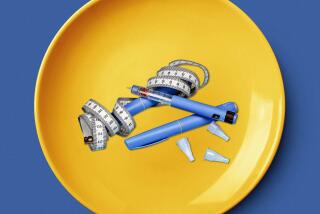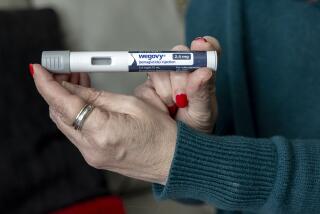UCLA-backed m-health project aids at-risk women using fitness app
- Share via
Qiana Sago knew she had a problem.
Three years ago, at age 30, she weighed 269 pounds. She was taking pills for high blood pressure. Her triglycerides were “the highest you can have,” she said.
Working as an LAX custodian, she was surrounded by fast food, which became a daily staple. “You ate [it] when you got to work, you ate it again midday,” she said. “Then I’d get off work and eat more.”
But, partly because she was provided access to unique fitness technology, the Inglewood resident has turned things around — losing more than 40 pounds and working toward the day she can stop taking blood pressure medication.
Sago and 39 other young African American women at Faithful Central Bible Church recently participated in a UCLA-backed clinical trial that used a smartphone app to track their eating and activity and teach them healthful diet and exercise habits.
Many such mobile health, or “m-health,” programs are in their infancy. But researchers and advocates for underserved, hard-to-reach patient groups hope they soon will contribute to major advances in the treatment of diabetes, heart disease and other chronic conditions.
Cellphones provide unprecedented, low-cost access to patients, experts say, because the technology is so widely used and the socioeconomic digital divide is shrinking. The Pew Research Internet Project reported earlier this year that 84% of U.S. adults with incomes below $30,000 a year had cellphones; 47% had smartphones.
Increasingly, phones — not home-based broadband connections — are the gateway to the Internet for all Americans.
“Anything that you’re doing online, that you want to extend to a low-income population, the way they’re most likely to access it is through mobile,” said Margaret Laws of the California Health Care Foundation in Oakland. Laws runs a program that hopes to use technology to help at-risk groups.
“Everyone has a phone, even if it’s a throwaway,” added UCLA psychologist and researcher Vickie Mays.
Mays, who leads a center that focuses on addressing health disparities, collaborates with the university’s Wireless Health Institute, which backed the Inglewood study. Mobile technology offers a powerful tool to assist people seeking to change bad eating and lifestyle habits, she said, because it can reinforce medical advice after a patient leaves the doctor’s office.
Heart disease among young black women — a long-recognized problem — appeared to be an ideal condition to target with m-health programs, said Jo-Ann Eastwood, a nurse practitioner and associate professor at UCLA’s School of Nursing who ran the church group study.
“I was tired of seeing women come in at 55 years old and they’ve already had a heart attack,” she said. “Their illness hadn’t been picked up early enough. That’s what drew me to this population: Where could I do the most good?”
Sago and the other women selected for the study all were between 25 and 45 at the time and had at least two risk factors for heart disease. They knew that they needed to eat well and exercise. But many said they were too busy caring for their children and parents — and working long hours — to find time to care for themselves. They also needed help understanding nutrition labels.
Eastwood taught the women about healthy-heart lifestyles and stress reduction in four diet-and-exercise classes before handing out custom-configured Android phones.
The devices were disabled for voice calls but could be used to text others in the study group. The phones were loaded with an app, developed at UCLA, that interacted with the women, sending daily and weekly questions — “Did you eat five to six servings of fruit today?” — and tracking how much exercise they got via built-in accelerometers.
Study participants were supposed to wear the smartphones whenever they were awake. They also had to measure their blood pressure on Sunday nights, using Bluetooth-equipped blood-pressure cuffs that sent readings to the phones, which then streamed the data to the researchers.
It took time to make the system work as planned, said Nabil Alshurafa, a PhD candidate who spent many days at Faithful Central tweaking the phone app. One challenge was figuring out a comfortable way for the women to wear the phones during waking hours. He and Eastwood ultimately opted for passport pouches worn around the waist.
Eventually most of the women got used to lugging around the phones, which logged movement data several times a second.
Blood-pressure readings spiked after the Fourth of July, the researchers noticed — a holiday when the women had loaded up on salty foods. Due to signal and data variations, Alshurafa could also tell when one participant faked her workouts by shaking the phone in her hand instead of taking walks.
When unusual patterns of data were spotted, a nurse would give the subject a call, which at wavering moments reinforced the idea that someone was watching and that the diet and exercise goals were important, Alshurafa said.
Preliminary results from the study have been promising. Compared with a control group, the church women had significant improvements in blood pressure and cholesterol levels, lower levels of anxiety and stress and improved eating and exercise habits. The UCLA team reported their findings last month at an American Heart Assn. scientific meeting in Chicago.
“They changed things that are very important for heart disease,” Eastwood said, adding that many participants said the program had made them and their families healthier.
Sago, now 33 and a full-time student, cut red meat out of her diet and loaded up on vegetables. In addition to losing weight, she significantly improved her blood pressure and triglycerides.
The smartphone helped keep her honest.
“Everybody lies to themselves,” she said. “But when you use the phone, you can’t really lie. You can’t cheat. The phone showed that you did the work. It kept track every time you moved.”
The phones appear to have been key in prompting transformations like Sago’s, Eastwood said.
“Women like to be connected,” she said. “This was a good way for them to have some social support … someone to cheer them on and keep them on the right track.”
Eastwood will continue analyzing results in the coming months and hopes to revisit the women in a year and see how they’ve fared.
The Rev. Jackie Russell, Faithful Central Bible Church’s director of community services and an early champion of the UCLA project, said such programs won’t help everyone. But she thinks that if a cellphone app gets even a few of the 3,000 who come to the church each Sunday to improve how they eat or increase their exercise, it will be a success.
“If we throw a wide net, we expect to catch some,” she said.
eryn.brown@latimes.com
Twitter: @LATerynbrown
Times staff writer Eryn Brown reported aspects of this story while participating in the California Endowment Health Journalism Fellowships, a program of USC’s Annenberg School of Journalism.
More to Read
Sign up for Essential California
The most important California stories and recommendations in your inbox every morning.
You may occasionally receive promotional content from the Los Angeles Times.











